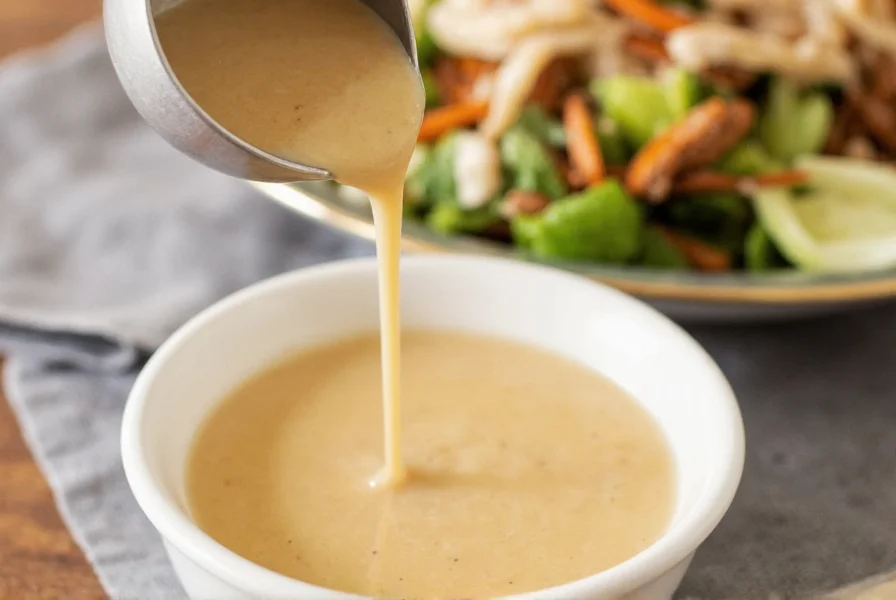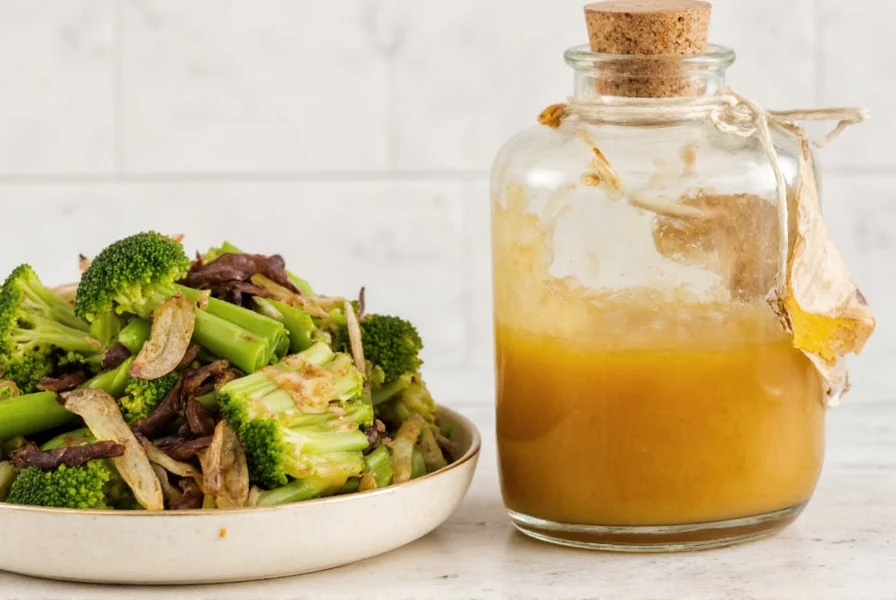If you've ever wondered what makes sesame ginger dressing such a popular choice in Asian cuisine and beyond, you're not alone. This vibrant dressing combines the nutty richness of sesame with the bright zing of fresh ginger to create a flavor profile that elevates simple ingredients into something extraordinary. Unlike many store-bought versions that contain preservatives and excessive sugar, making your own sesame ginger dressing allows you to control the ingredients and tailor the flavor to your preference.
The Essential Components of Authentic Sesame Ginger Dressing
Creating a balanced sesame ginger dressing requires understanding how each ingredient contributes to the final flavor profile. The foundation typically includes:
- Toasted sesame oil (1-2 tbsp) - provides deep nutty flavor (never use untoasted)
- Freshly grated ginger (1-2 tbsp) - delivers the characteristic zing
- Rice vinegar (2-3 tbsp) - offers mild acidity that complements Asian flavors
- Soy sauce or tamari (2 tbsp) - adds saltiness and umami depth
- Natural sweetener (1-2 tbsp honey, maple syrup, or sugar) - balances acidity
- Neutral oil (2-3 tbsp grapeseed or avocado oil) - helps emulsify the dressing
- Garlic (1 clove, minced) - enhances complexity (optional)
- Sesame seeds (1 tsp) - adds texture and visual appeal
| Ingredient | Traditional Amount | Flavor Contribution | Substitution Options |
|---|---|---|---|
| Toasted sesame oil | 1-2 tbsp | Nutty, roasted depth | Hoisin sauce (reduced amount) |
| Fresh ginger | 1-2 tbsp grated | Spicy, aromatic warmth | Ginger paste (1/2 amount) |
| Rice vinegar | 2-3 tbsp | Mild acidity | Apple cider vinegar + pinch sugar |
| Soy sauce | 2 tbsp | Saltiness, umami | Coconut aminos (for gluten-free) |
Traditional Origins and Modern Adaptations
Sesame ginger dressing has roots in Japanese and Chinese culinary traditions, where sesame oil has been used for thousands of years. Traditional versions were simpler, often just sesame oil, vinegar, and salt. The modern iteration popular in Western cuisine emerged as Asian fusion cooking gained popularity in the 1980s and 1990s.
When crafting an authentic homemade sesame ginger dressing recipe, the quality of ingredients makes a significant difference. Freshly grated ginger provides a brighter, more complex flavor than powdered ginger, while toasted sesame oil should be used sparingly due to its strong flavor and low smoke point. Many professional chefs recommend using a 3:1 ratio of neutral oil to toasted sesame oil to achieve balanced flavor without overwhelming bitterness.

Perfecting Your Sesame Ginger Dressing Technique
The key to a well-emulsified sesame ginger dressing lies in the preparation method. Start by whisking together your liquid ingredients before slowly drizzling in the oils. This gradual incorporation creates a stable emulsion that won't separate immediately. For the smoothest texture, many chefs recommend using a small blender or immersion blender rather than hand-whisking.
One professional technique for enhancing flavor is blooming the ginger and garlic. Briefly heat the sesame oil with grated ginger and minced garlic over low heat for 1-2 minutes (being careful not to burn), then remove from heat and let cool before adding other ingredients. This process extracts more flavor compounds from the aromatics.
Versatile Applications Beyond Salad Dressing
While many people reach for sesame ginger dressing when making Asian-inspired salads, its applications extend far beyond. This versatile dressing serves equally well as:
- A marinade for chicken, salmon, or tofu (allow 30-60 minutes for best results)
- A dipping sauce for spring rolls or dumplings
- A flavor booster for grain bowls and noodle salads
- A drizzle over roasted vegetables like broccoli or asparagus
- A base for cold noodle dishes
For salad applications, sesame ginger dressing pairs particularly well with crisp vegetables like romaine, napa cabbage, and snow peas. Add-ins like mandarin oranges, almonds, and grilled chicken transform a simple green salad into a complete meal. When using as a marinade, the acid in the vinegar helps tenderize proteins while the oil carries flavor deep into the food.
Storage Guidelines and Shelf Life
Homemade sesame ginger dressing lacks the preservatives found in commercial varieties, so proper storage is essential. Store your dressing in an airtight container in the refrigerator for up to one week. The natural separation of oils is normal—simply shake or whisk before each use.
For longer storage, consider freezing portions in ice cube trays, then transferring the frozen cubes to a freezer bag. Frozen dressing maintains quality for up to three months and can be thawed overnight in the refrigerator before use. Avoid storing dressing at room temperature for more than two hours due to the fresh ginger and potential bacterial growth.
Common Mistakes to Avoid
Even experienced home cooks sometimes make these errors when preparing sesame ginger dressing:
- Using untoasted sesame oil (lacks depth and nuttiness)
- Adding too much toasted sesame oil (overpowering and bitter)
- Using dried ginger instead of fresh (results in flat flavor)
- Not balancing the sweet-sour-salty elements properly
- Creating an unstable emulsion that separates immediately
The perfect sesame ginger dressing should have a harmonious balance where no single flavor dominates. Taste as you go and adjust ingredients incrementally until you achieve your preferred flavor profile. Remember that dressing flavors often mellow slightly after sitting for 30 minutes as the ingredients marry.
Nutritional Profile and Dietary Considerations
A standard 2-tablespoon serving of homemade sesame ginger dressing contains approximately:
- Calories: 120-150
- Total fat: 12-14g (mostly unsaturated)
- Carbohydrates: 4-6g
- Sugar: 3-5g (depending on sweetener)
- Sodium: 300-400mg
For those seeking healthier sesame ginger dressing options, consider these modifications:
- Reduce oil content by adding a tablespoon of water or vegetable broth
- Use coconut aminos instead of soy sauce for lower sodium
- Substitute honey with a sugar-free alternative like monk fruit
- Add a teaspoon of tahini for creaminess without extra oil
Unlike many store-bought varieties that contain added sugars, preservatives, and artificial flavors, homemade versions give you complete control over ingredients and nutritional content. This makes it easier to accommodate specific dietary needs while maintaining authentic flavor.
Conclusion: Mastering the Art of Sesame Ginger Dressing
Sesame ginger dressing represents one of the simplest yet most transformative elements in your culinary repertoire. By understanding the role of each ingredient and mastering the proper technique, you can create a dressing that elevates ordinary meals into extraordinary dining experiences. Whether you're preparing a quick weeknight salad or marinating proteins for a special occasion, this versatile dressing delivers consistent flavor and versatility.
The beauty of this homemade sesame ginger dressing recipe lies in its adaptability—tweak the ratios to match your personal taste preferences, and don't be afraid to experiment with additional ingredients like citrus zest, chili flakes, or different sweeteners. Once you've mastered the basic formula, you'll find countless opportunities to incorporate this vibrant dressing into your regular meal rotation.
What's the difference between sesame oil and toasted sesame oil in dressing recipes?
Toasted sesame oil has been roasted, giving it a much stronger, nuttier flavor compared to regular sesame oil. For sesame ginger dressing, you should always use toasted sesame oil as it provides the characteristic flavor. Regular sesame oil lacks the depth needed and won't deliver authentic results. Use toasted sesame oil sparingly (1-2 tablespoons per recipe) as its flavor is potent.
How can I prevent my sesame ginger dressing from separating?
To create a stable emulsion that won't separate quickly, slowly drizzle neutral oil into the other ingredients while whisking vigorously. Using a small blender or immersion blender creates the most stable emulsion. Adding 1/2 teaspoon of Dijon mustard also helps bind the ingredients. Even with proper technique, some separation is natural—simply shake or whisk before each use.
Can I make sesame ginger dressing without soy sauce?
Yes, you can substitute soy sauce with coconut aminos for a gluten-free option with slightly sweeter flavor, or use liquid aminos for a similar umami profile. For a completely different approach, try 1 tablespoon of miso paste diluted with 1 tablespoon of water. Each alternative will create a slightly different flavor profile but will still work well as a sesame ginger dressing base.
What dishes pair best with sesame ginger dressing?
Sesame ginger dressing complements Asian-inspired salads with napa cabbage, snow peas, and carrots. It also works wonderfully as a marinade for salmon, chicken, or tofu, and makes an excellent dressing for grain bowls featuring quinoa or brown rice. Try it as a dipping sauce for spring rolls or as a flavor boost for cold noodle salads. The dressing's versatility extends to roasted vegetables like broccoli and asparagus as well.
How long does homemade sesame ginger dressing last in the refrigerator?
Properly stored in an airtight container, homemade sesame ginger dressing will maintain its best quality for 5-7 days in the refrigerator. The fresh ginger and lack of preservatives mean it won't last as long as commercial varieties. You'll know it's gone bad if you notice any off smells, mold, or significant changes in texture. For longer storage, freeze portions in ice cube trays for up to three months.











 浙公网安备
33010002000092号
浙公网安备
33010002000092号 浙B2-20120091-4
浙B2-20120091-4